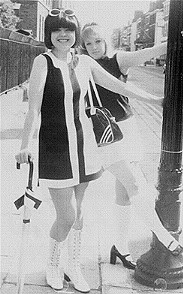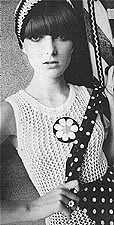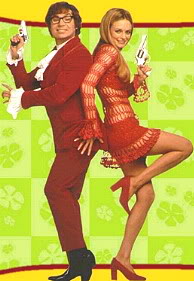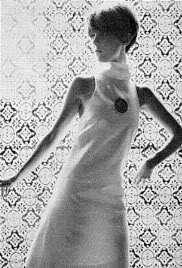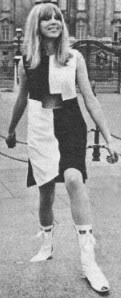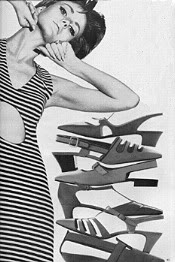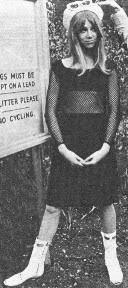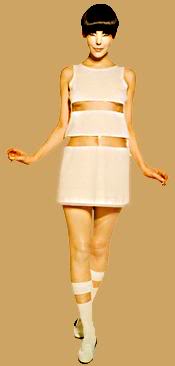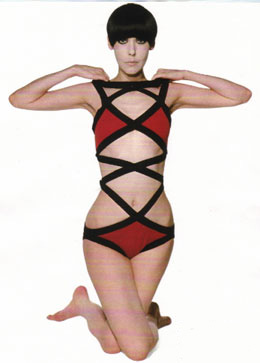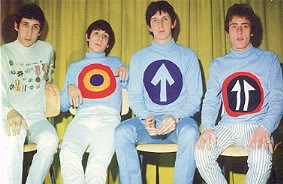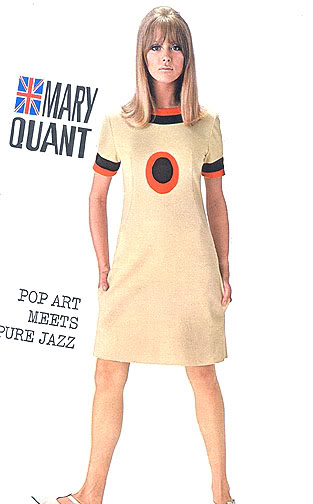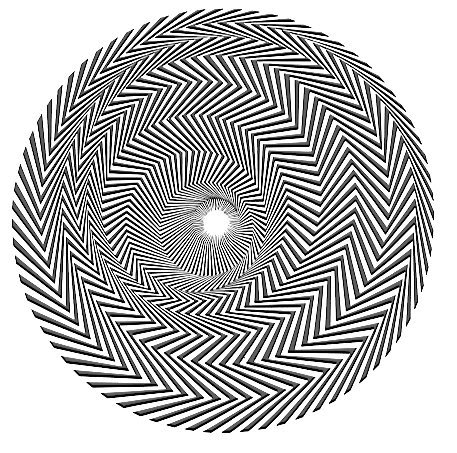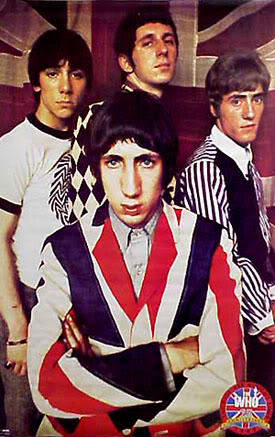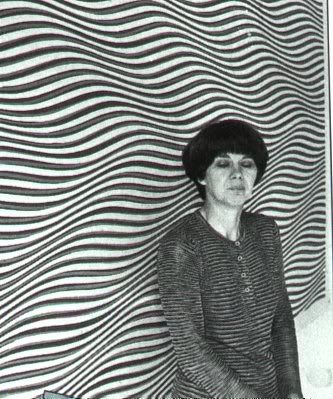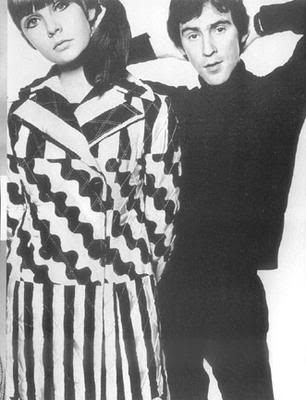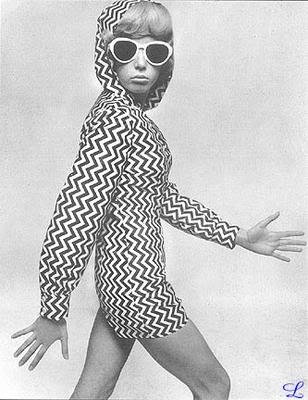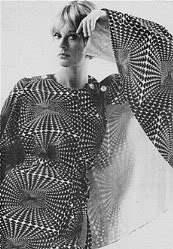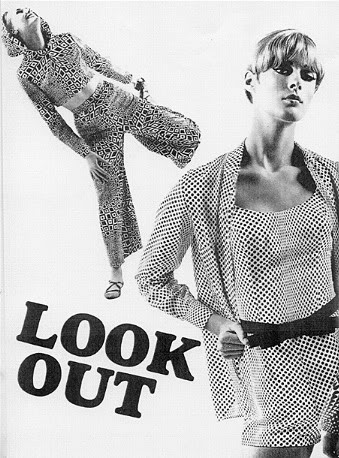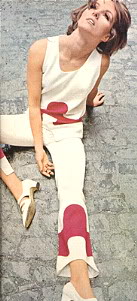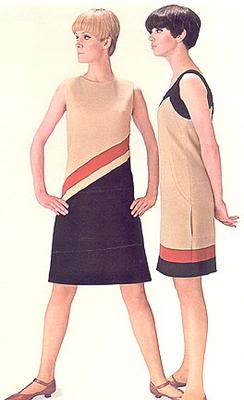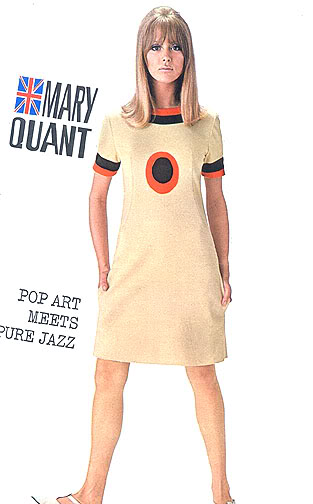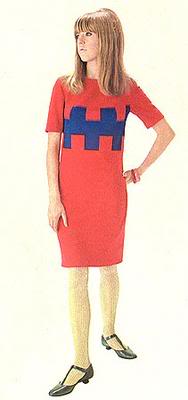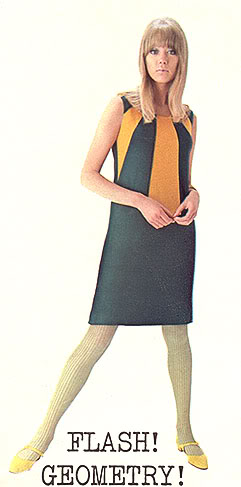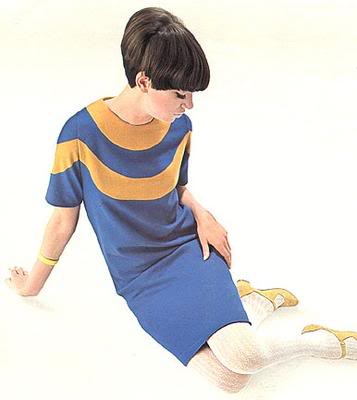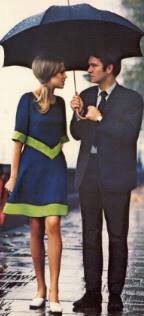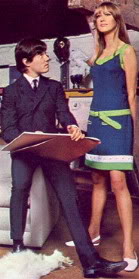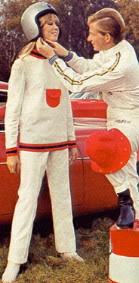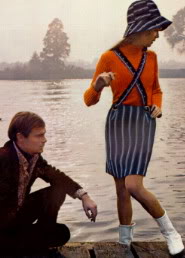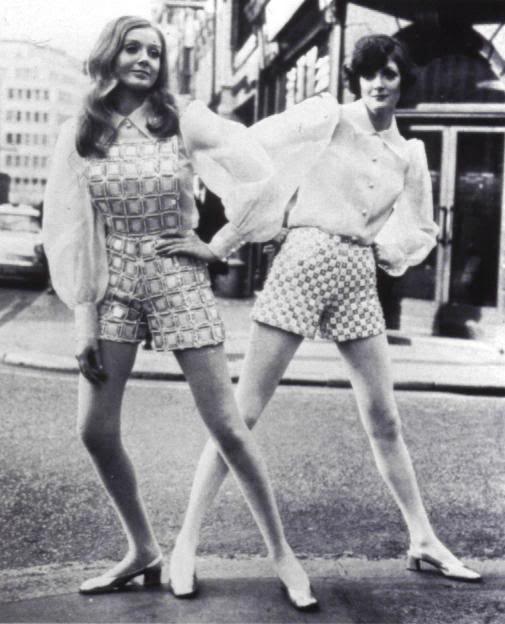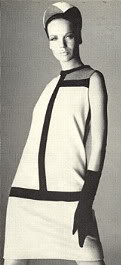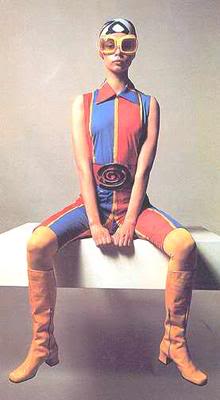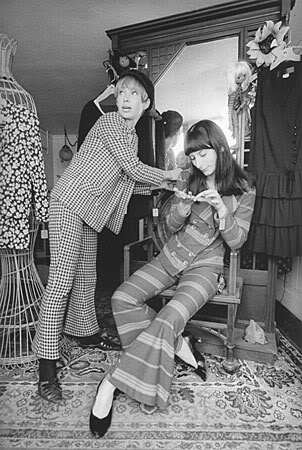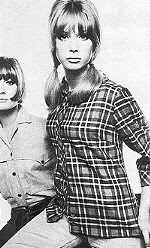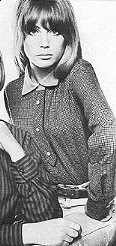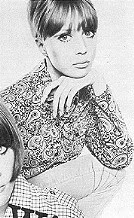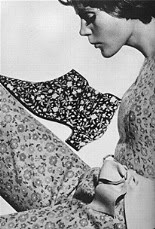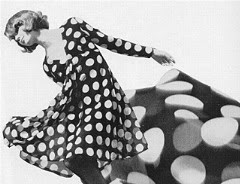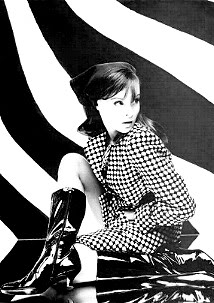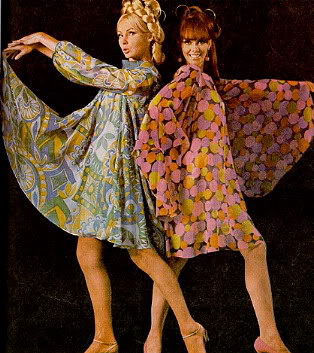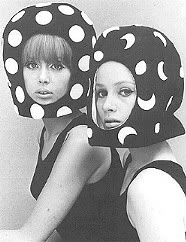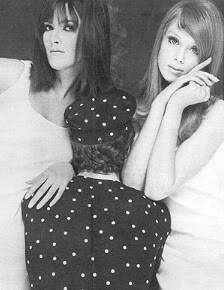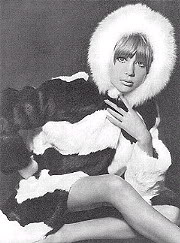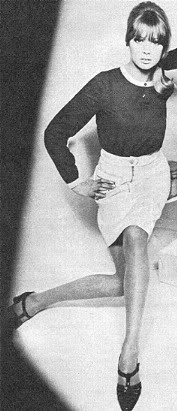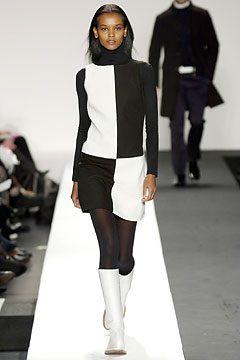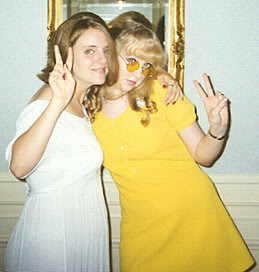Fashion trends of the mid 1960s
I’m known as Senti (a nickname with a long history) and I am totally stuck in a 1960s timewarp. I missed the 1960s myself – being born in 1979 – but developed a love for this decade very early on, and now live in a 1960s house decorated with the appropriate vintage wallpaper and furniture, wear mainly 1960s clothes, am a self confessed knee-high boot addict.
Not having lived through the fashions at the time, I’ve discovered them via films from the era and stacks of 1960s fashion magazines… so I can usually pin down each look to a specific season and know what hairstyles and accessories would have been worn with it when it first came out.
My particular fashion idol of the era is Beatle girlfriend, model Pattie Boyd – so you’ll be seeing quite a lot of her here – and I have a love of the Dollyrockers range that Samuel Sherman created.
I’ve chosen to talk about the fashion trends that took place in the mid 1960s (focusing around 1965 and spilling over into 1966) as this is the era that the most striking styles come from. The looks that film and television shows aim for when recreating the decade, the ideas that pop into people’s heads when setting up a swinging sixties fancy-dress party… and more importantly as far as I am concerned, the clothes that the mod crowd of today are on the look-out for.
THE BRITISH STYLE OF THE MODS
1965 was about the end of the mod scene in the UK. Mods were about style, sophistication, sharpness and individuality… and by 1965 the media had caught up with them and everything they did was soon being copied by people across the country. Their look would soon be copied and adapted across the Atlantic in America, and this large-scale reproduction of “mod style” more or less killed the movement off in England.
But the desire to be a mod, and to be considered sharp, stylish and individual never went away. So, four decades later, there is still a booming mod scene throughout Europe, and a thriving 1960s scene basing itself on mod in the USA. The only difference is that these days mods don’t create all the newest trends, they emulate the look that was copied across the world in mod’s heyday. It’s as though the fashions, attitudes and music of 1965 and 1966 are frozen and preserved.
So if you’re a wannabe mod, this is going to be your guide of the hottest fashions to get hold of, and if you’re selling this kind of gear, you need to know your mod audience… and mods are determined to have perfection.
The look is sharp, far out, often quite kooky, and most definitely British. And as much as we love our designer labels here at the VFG, those too are out. Christian Dior is not going to create a stir among the mod crowd, and they were not the forerunners of mid-sixties style.
For the majority of the 1960s, the driving force behind fashion was no longer the big established houses of Parisian haute couture but small London boutiques run by way out unknowns whose names and creations would soon go down in fashion, cultural and social history.
Among them there were Ossie Clarke’s Quorum, Lee Bender’s Bustop, Mary Quant’s Bazaar, and Barbara Hulanicki’s Biba which attracted 100,000 visitors a week in it’s heyday.
So as they said in Vogue during 1965, “In New York it’s the ‘London Look’, in Paris it’s ‘le style anglais’,”
I’m now going to focus on a few of the major ideas that shaped mid-sixties fashion:
cut-outs
pop-art and op-art
geometric
black and white
vintage
CUT–OUTS
As British teen magazine Fabulous remarked in the Summer of 1965 when they asked Pattie Boyd to model the latest fashions for them, “this year it’s the Bit Of Dress That Isn’t There that’s making the greatest impact!”
For those who are striving to achieve the perfect 1960s look these days, the hardest essential item to find for your swinging wardrobe is the perfect little crochet dress… and even more difficult is the age old concern of what to wear under it!
Crochet dresses were one of those 1960s styles you had to be brave to wear when the classic version was a white figure hugging mini dress with a generous supply of holes which were sometimes just a little too large and a little too close together.
“Every girl had a little crochet number. It was the ultimate dolly-bird dress. The only problem was what to wear underneath it. Unless you really wanted to let everything hang out, you had to get one of those new flesh coloured body stockings” remembers a teen of the 1960s.
For those of you who do manage to find a groovy little crochet number to sell in your stores, it’s best to market it to the brave and sexy by suggesting it be worn with skin-tone underwear or – if the holes are small enough that you can get away with it – underwear precisely the same colour as the crochet yarn.
For the less brave who are still determined to have this sort of item in their collection and go out in it, it is now almost impossible to find the bodystockings designed for this purpose in the 1960s… but a modern equivalent is to visit a dancewear shop and purchase the flesh-coloured undergarments that ballerinas wear – like a flesh-coloured leotard but very low-cut at both the front and back, and with very thin spaghetti straps. This way it looks like you’re being reckless and wearing nothing underneath, but you are safe in the knowledge you’re not going to show anything you shouldn’t.
More modern versions of the little 1960s crochet dresses are much easier to wear as the pattern of holes are thought out so as to conceal certain areas. A perfect example of this is the one Heather Graham wore in Austin Powers, which although it’s not an original 1960s dress, I’d definitely not say no if it were offered to me.
If you weren’t brave enough to have crochet holes everywhere, 1965 came to the rescue when cutouts were the style. Holes big or small cut into mainly black and white fabric because cutouts were part of the whole op art boom when everyone was nicking the black and white creations of artist Bridget Riley (as I will come to discuss later on). Cutouts in your dress, cutouts on the toes of your shoes, cutouts making a pattern on the top of your Courreges style boots.
For the “retro-style” clothes of the 1960s revival in the 1990s, cut-outs were entirely placed so that they would reveal your cleavage. This sort of fashion is still wildly popular with those attending 1960s fancy-dress events, and for the newbies to the 1960s scene. But for those in the mod scene who are prepared to spend cold hard cash on clothes with cut-outs, nothing but the stylish original discreet cut-outs will do.
Cut-outs in clothing from 1965 and 1966 are singular large cut-outs in the upper half of a dress whereas cut-outs later on in the decade tended to be multiple cut-outs in a band across the chest waist or hemline of an outfit, often using a daisy pattern or some other such novelty shaped cut-out. The early look is easily identified as discreet and stylish, while the later is fun, bright bold and very youthful.
The absolute classic-look cut-out item of the era, sought after by wardrobe people in the film industry, those attending 60s fancy-dress events, and also the mod crowd and 1960s fashion collectors is the black and white panelled dress with a central cut-out. Inferior copies of these were widespread in the 1990s, but an original complete with a recognisable 1960s name such as Dollyrockers, Angela Cash, Blanes, Mary Quant, or Foale and Tuffin would be a tremendous find.
A perfect example of this kind of item is shown below, complete with it’s 1965 caption… please also note the cut-out boots with cut-out toes and cut-outs around the top. These were made by the theatrical shoemakers Anello and Davide (who also made the famous Beatle Boots) and were probably the most popular footwear worn by any of the female in-crowd of the 1960s.
Cut-outs on footwear were most definitely not just for go-go boots, in 1965 and 1966, cut-outs all over shoes were almost an absolute essential.
In 1965 fishnet also moved from your stockings to the midriff of your dress or top and made up the entirety of your sleeves too. This was a much more easily wearable style which lasted for a relatively short period of time, and can instantly pin-down an outfit to this era when seen on more conservative outfits such as knee-length dresses, ankle length dresses with a slit up the side, and casual trouser suits.
Some of the most fabulous – and also the least comfortable and wearable – outfits from the cut-out phase were created by Austrian designer Rudi Gernreich.
Gernreich became particularly famous in 1964 when he designed a topless swimsuit… but the cutout designs tht came later were much more wearable and showed a flair for drawing attention to “the Bit Of Dress That Isn’t There”.
Rudi’s take on the cut-out was a little different to other designers. Sometimes there were so many cutouts that the item was made up entirely of the thin bits imbetween the holes… and another fabulous and innovative idea used the new vinyl fabric that Mary Quant had perfected, placing see-through plastic in place of the holes. The problem with those of course was that vinyl was rather hot and uncomfortable to wear in those early stages before the fabric was perfected, and the see-through sections had a tendancy to steam up!
Here are a couple of my favourite cut-out outfits designed by Rudi, modelled of course by the fabulous Peggy Moffit who worked exclusively for Gernreich in the 1960s and 1970s.
POP ART & OP ART
The Pop Art boom inspiration obviously came from comic book style art, but it’s strong foundations in fashion and the whole reason it suddenly became such a popular fashion statement was actually down to a pop musician.
In 1965 a mod band called The Who become wildly popular. The were loud, forceful, brash and determined to stand out in every way possible. They’d been groomed a few years previously by Mod Ace Face, Pete Meaden, who had turned them all onto the mod scene and it’s stylish cutting-edge ways. There were a few grumbles amongst some of the group as they were persuaded into the usual mod gear, but the songwriter and lead guitarist of the group – Pete Townshend loved ever minute of it.
He was an art school student and while studying he had been trained in some radical new art ideas and also met his future wife Karen who was studying fashion design. With mod, all the new ideas came together, and Pete soon stopped the band being a step behind the mods, copying their fashions and started creating his own.
He got rid of the regular striped mod shirts and created a style for the band based on pop images – targets, flags, comic book images such as the Superman logo and slogans such as “zap!” and “pow!” – which quickly caught on. As a very visual band as far as their stage show was concerned, they were instantly popular with the media and their new fashions were soon splashed all over magazines and teenage TV shows such as Ready Steady Go and A Whole Scene Going.
This bold new fashion fad – that was easy to manufacture at home with a few bits of brightly coloured material cut into bold shapes and stuck on dresses, coats and sweaters – was soon adopted by the fashion designers of the day, and soon even the fabulous Mary Quant was using Pete’s ideas.
Another art based fashion that became wildly popular around this time was Op Art, an art form popularised by artist Bridget Riley who created amazingly fascinating pieces of work using a series of black and white shapes and patterns of different thicknesses and positions to create the optical illusion that the flat art work was bulging, twisting or moving in front of your eyes.
Everyone was so enthralled with Riley’s work that it started to appear on absolutely everything, from wallpaper to dress and upholstery fabric.
Bridget herself was not impressed with this widespread fashion appreciation of her work. “I’ve yet to see an Op Art fabric which is wearable.” Riley said in 1966 to Queen magazine, “I think they’re ugly beyond belief.”
As op-art has again become quite widespread on fashion in the past few years, you will only really be able to identify 1960s op-art by the type of fabric, label, and the style of the item. Modern versions do tend to be more conservative than the 1960s versions, so if you find something totally over-the-top using masses of fine op-art print then you can almost be certain it’s an item from 1965.
These examples of beach-wear issued during the op-art boom were from a selection designed by Rose Marie Reid and sold at Harvey Nichols and Kurt Geiger.
GEOMETRIC
A particular favourite fashion style of mine is geometric fashion. Made up of bold coloured fabrics cut into sharp lines that do not cling to the wearer or follow their shape, but create entirely their own shape and look. The aim of geometric fashion was – for once – to draw attention away from the wearer and onto the fashion itself. When you wear a geometric dress you almost become the dress, adopting it’s shape, it’s boldness.
Geometric outfits did not come in patterned material, they were usually made up of panels of vividly coloured fabric, and the motifs found on them were as sharp and bold as the shape of the outfits themselves. This style of clothing was soon adopted for use by the airline companies, dressing each stewardess in a sharp, smart and bold outfit that would instantly stand out among any airport crowd – and that bizarrely could exactly match the logo and decoration of the aeroplane itself.
The British geometric style of 1965 was dramatically introduced to the US during the YouthQuake tour when the hottest young designers Mary Quant, Marion Foale and Sally Tuffin grouped together and took their fashions on tour almost like a pop group. To add to the pop-group vibe, their star models of the tour included Beatle George Harrison’s girlfriend Pattie Boyd and her sister Jenny who worked alongside Sandra Moss and Sarah Dawson.
The Youthquake label was launched in the US as part of Puritan Fashions and was still going strong by the end of the decade. The bright and bold geometric clothing of the Youthquake tour was popular enough that a selection of Mary Quant’s spring 1966 fashion range along the same lines was launched on the Youthquake label and again promoted by Beatlegirl Pattie Boyd.
The Paris designers also used a lot of geometry in their designs during this period, but the look they created was stark rather than bold and fun. They also mainly failed to use to vivid colours that designers such as Quant and Foale and Tuffin used which tended to give their outfits a rather bland look.
The geometric style produced some amazing eye-catching outfits that were perfect at hiding the shape of the wearer and creating a whole new shape and appearance all by themselves… but as the look progressed over the decade, it went rather extreme and never managed to improve or even match the success of the look when it was launched in the mid 1960s.
As you can see in the example below, by 1969 the bold bright colours and strong geometric shapes had gone to the extreme and had completely wiped out the femininity of the wearer.
As you can see from the pictures we’re going through now (and the discussion about stockings being too short), hemlines are creeping up a little bit. We’ve gone from just resting over the knee, to being above the knee and gradually showing a bit more thigh.
In retaliation to everyone showing their legs, trousers became very popular for women. Mary Quant had been trying to get girls into trouser suits and culottes for quite a few years, but with the threat of raising hemlines in 1966 girls finally began to accept trousers as something that could be fun and fashionable, and weren’t just for traipsing round the countryside in and getting muddy with the men.
Despite the general distaste among the mods for the hippie style flared playsuits that came out around this time, the mods had always been into fashions that could easily be worn by both sexes and trousers were of course much easier to wear than a mini-skirt while riding a scooter.
So the mod take on trousers-for-girls was slacks and printed blouses. A look very much favoured by the mods these days, but the female printed shirts do prove quite difficult to track down. A particularly good make of modette shirts is Slimma whose blouses almost match the mens shirts of that era in sharpness of style. Smart prints using blues and reds are particularly popular, especially on shirts with collars and cuffs in a contrasting plain colour. Here are a few examples – modelled by Pattie again of course – of the best makes that todays mods are after.
Around this time fine detailed prints (think William Morris) were in for Summer dresses with matching headscarves, trouser suits and boots.
Polka dots had a very short lived fashion moment in the mid-sixties when they got caught up in the love for black and white prints. They were in at the start of 1965 according to the highbrow magazines like Vogue, but the teen scene proved them quite unfashionable by the Summer.
BLACK AND WHITE vs BOLD COLOUR
The 1960s is known as the decade that brought colour into people’s lives, colour television, glorious colour films,magazines filled with full colour images of the stars of the day.
Now you no longer had to imagine the latest fashions in all their glory by reading the text of how the bland black and white image on the opposite page was really a “marshmallow pink” creation or a real “colour asset”. Now you could see the clothes in the fashion magazines in all their colourful glory… and there were no marshmallow pinks anymore, it was all “raspberry pink” and “orange fizz”. Bold, bright and beautiful.
London menswear designer John Michael explained that the riotous colours now appearing on men’s shirts were “not so much to do with fashion as much as the social revolution”. Bright new fashions were created by the bright new working class who no longer wanted to be drab and inconspicuous like their fathers, but wanted to “burst out into colours and exotica… they are larger than life and want to look larger than life.” A member of the Chelsea set who actually wore these bright coloured fabrics put some of it down to the fact that “Drugs are fantastically important… the part they play in people’s dress sense turns them onto colour.”
Almost as a reaction to this riotous explosion of colour clothing the youth were wearing en-masse, the Spring season of 1965 brought about a brand new trend – black and white – which was still vastly popular in the Summer season too. People dressed entirely in black, entirely in white, most used bold mixes of the two in a combination that is still considered the epitome of the 60s look… or if you followed the guidelines of Honey Magazine in April of 1965:
“Be a black-and-white girl. Mix lots of the whitest white with a dash of black. Dab on a dot of brilliant colour and you have the newest look for spring – a bold and beautiful look for girls who are positive-plus.”
This look – as you can imagine – worked fabulously with the trends for op-art fabrics, cut-outs and geometric fashions, all of which were incredibly striking in black and white.
This black and white trend is still probably one of the most copied looks of the 1960s, becoming widespread in the 1990s, and re-appearing again only a few years later in 2003.
VINTAGE
The fashion trend of 1965 most likely to interest everyone here is the epidemic of vintage clothing shops and the desire to recreate the look of ages past.
Despite all the throwing out of the old ways and the stream of fresh new ideas, vintage clothing became a major trend in the middle of the 1960s. Vogue dedicated an article to the “Attic Dress of 1965 Dandies” who grew bored of wearing the same as everyone else and began to search out their grandfathers’ clothes in the attic so that they’d have something totally different to wear: “Those without attics search the markets (Portobello Road, Bixton, Church Street, Paddington). Those with the dosh… are having things made up by the sort of tailors who are amazed at nothing.”
The fashion designers who had spent the first half of the decade clamouring to create something entirely new and different began reaching back in time to create vintage styled clothing to sell new in the shops.
This of course culminated in the “thirties look” popularised at the end of the sixties. An excessively popular trend amongst women, with the hairstyles and make-up becoming essential as well as the clothes. Thirties style wigs were created as well as whole ranges of make-up with old styled nail polishes, eye shadows and lipsticks in “thirties reds”.
But back in 1965 and 1966, it was all about true-blue vintage clothing. The movement was largely lead by a Victorian clothing collector called Sheila Cohen who started the most famous vintage-fashion boutique, “Granny Takes A Trip”. Her boyfriend at the time was the painter Nigel Waymouth (part of the psychedelic design team “Hapshash & The Coloured Coat” who produced many famous psychedelic and surreal posters, record covers and murals) whose friend John Pearse was a well-renowned mod tailor.
Sheila’s love of vintage clothing inspired the idea of the boutique when John’s mod mind realised that vintage was the only way to go if you wanted a truly individual outfit. Soon Nigel’s mind too was caught up in the idea, realising that he had the opportunity to create a complimentary range of new clothing that would sell alongside the vintage. At the close of 1965 the successful trio moved from their vintage clothing stall into premises at 488 King’s Road and the legend of Granny Takes A Trip began.
